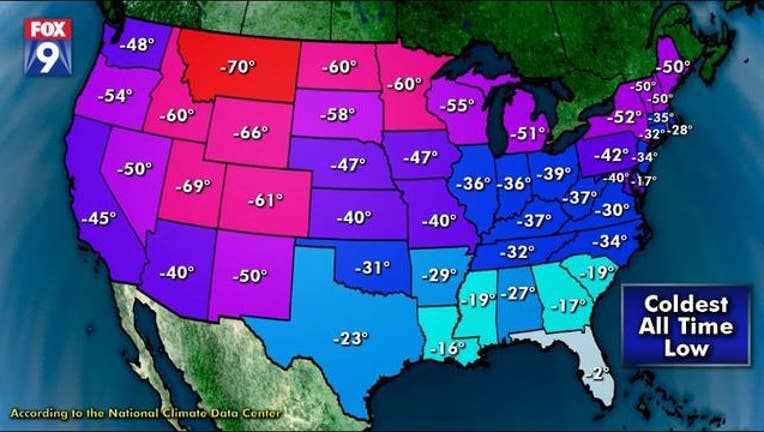How cold does it get in the States?

KMSP - Many of you may have heard that the thermometer tumbled to 88 degrees below zero in a village in eastern Russia. It is considered to be the coldest permanently habited cities in the world with all of 500 residents.
At -88° you can get frostbite in about a minute and can freeze to death in less than 10, so residents have to take extreme precautions to stay warm just in case they have some unforeseen circumstances. All residents have backup generators for example. But even then, accidents do happen. Just last week, a couple of people froze to death after they tried hiking for a couple miles after they had car trouble.
While not nearly that extreme in United States, there are still some pretty cold temperatures at times. The map above represents the coldest temperatures ever recorded in each state in the Lower 48. What may surprise you is what state actually leads the list; it’s Montana at -70°. Second place? Utah surprisingly enough. For Minnesota, we are in the -60° club when Tower hit that temp for the first and last time back in early February of 1996. That same day was the last time the Twin Cities officially hit -30° (actually got to -32°).
This map will also show you that every single state (including Hawaii) has been below zero at some point. Florida is clearly in last place making it below zero on just one day in history. While Montana is first place for the Lower 48, we didn’t forget our neighbor to the north Alaska, topping the U.S. with a -80°.
So what does it take to get temperatures this cold? Well honestly, it takes near perfect conditions which is why it doesn’t happen that often.
You can probably guess you need really cold air, probably coming from the Arctic. But what you may not know, is that you need to be as far away from a large body of water as possible. Water is far less efficient to heat and/or cool, which makes it a relatively warm location on very cold nights. This distance from a large body of water is called continentality. You also need clear skies, calm winds, and snow on the ground. With clear skies, the longwave radiation coming from the Earth won’t be reflected back to the ground by cloud cover. This is a warming process. Also, with calm winds, the cold dense air can sink to the surface. Lastly, snow on the ground can insulate the really cold and dry air and can make things even colder with this insolation.
Like I said… perfect conditions.

